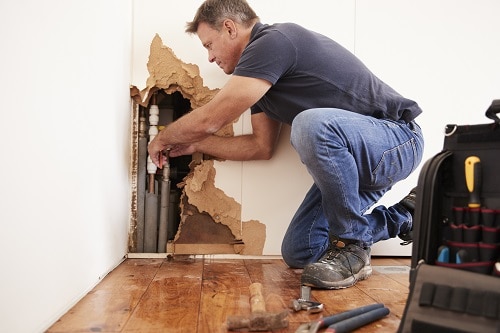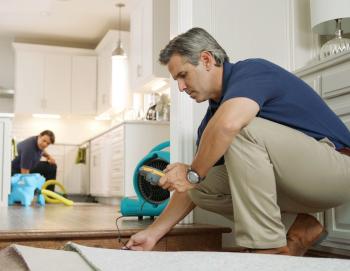Water Damage Restoration 101: Understanding the Process and Expense
Water damage can strike unexpectedly, leaving home owners in a state of complication. Understanding the remediation procedure is necessary for reliable healing. From examining the damage to picking the best company, each step affects the general result and expense. Elements such as the type of water damage and seriousness also play a significant role. What are the specific techniques used in reconstruction, and just how can one plan for possible costs?
Kinds Of Water Damage
Water damage can occur from various sources, each presenting unique obstacles for remediation. The three main sorts of water damage are categorized based upon contamination degrees: tidy water, gray water, and black water. Tidy water stems from sources like busted pipelines or rainwater, posing minimal health threats. Gray water, which consists of wastewater from sinks or cleaning devices, contains contaminants that might trigger pain or health problem if consumed. Black water, one of the most dangerous category, originates from sewer or floodwaters, including damaging germs and microorganisms. Each type requires details reconstruction techniques and precaution to efficiently minimize and deal with the damage wellness dangers. Understanding these differences is vital for property owners and experts included in the water damage restoration procedure.
Initial Evaluation and Examination
A comprehensive preliminary analysis and examination are vital action in the water damage repair procedure. This phase starts with a professional assessing the extent of the damage, identifying the resource of the water breach, and figuring out the type of water included - Flood Cleanup Services. Technicians make use of specialized tools to determine wetness degrees in various materials, such as walls, floors, and furnishings. In addition, they assess structural stability and prospective health and wellness dangers, including mold and mildew growth. The searchings for from this inspection inform the reconstruction strategy, assisting needed actions and resource allotment. Accurate documentation of the damage is necessary for insurance policy cases and future recommendation. On the whole, this first evaluation lays the foundation for efficient remediation, making certain a thorough action to the certain circumstance at hand

Water Extraction Techniques
Following the initial evaluation, reliable water extraction techniques are employed to minimize damage and protect against more problems. These techniques include using specific equipment such as completely submersible pumps and industrial-grade vacuums. The choice of approach depends upon the volume of water present and the type of products influenced. For standing water, submersible pumps are usually utilized for quick elimination, while vacuum cleaners are excellent for removing water from carpets and upholstery. Furthermore, progressed techniques like water removal mats may be used for hard-to-reach areas. The objective is to remove as much water as possible, minimizing the potential for mold development and structural damage. Motivate and efficient water removal is vital in the general water damage repair procedure.
Drying Out and Dehumidification Process
Once the water removal is total, the drying and dehumidification procedure becomes essential to bring back the damaged location. This stage typically uses industrial-grade dehumidifiers and air movers to successfully lower moisture levels. The dehumidifiers attract wet air, eliminating excess moisture, while air moving companies flow air to accelerate evaporation. Surveillance equipment is usually utilized to track humidity and temperature level levels, ensuring suitable drying problems. The period of this procedure can vary depending upon the degree of the water damage and ecological variables. It is important to completely completely dry all influenced products, consisting of wall surfaces, floor covering, and home furnishings, to stop mold growth and structural damage. Correct implementation of this action is essential for a successful reconstruction outcome.
Cleaning and Sanitizing Damaged Areas

Preliminary Assessment and Examination
Prior to starting any remediation efforts, a thorough preliminary analysis and examination of the impacted areas are vital for effective cleansing and sterilizing. This process involves identifying the extent of water damage, establishing the source of the water breach, and reviewing the materials influenced. Inspectors normally search for indicators of mold growth, architectural integrity problems, and harmed personal belongings. The assessment likewise consists of checking wetness degrees using customized equipment to ensure no surprise water pockets remain, as these can result in more complications. Recording the findings is vital for preparing the following action in the restoration procedure. A thorough preliminary analysis makes it possible for reconstruction professionals to develop a targeted strategy for reliable cleaning and sanitizing, eventually decreasing damage and wellness risks.
Cleaning Methods and Products
Efficient cleansing and disinfecting of water-damaged locations call for a click selection of techniques and products customized to the particular products impacted. For permeable surface areas like drywall and carpets, removal approaches are vital to remove excess moisture, followed by deep cleaning with specialized detergents. Non-porous products such as floor tile or steel can be cleansed utilizing commercial-grade cleansers that effectively remove pollutants. Heavy steam cleaning is another efficient method, particularly for carpets and furniture, as it makes use of high temperature levels to remove microorganisms and mold and mildew. Furthermore, eco-friendly products are increasingly preferred for their security and effectiveness. Ultimately, picking the proper cleaning methods and products not only assures prompt sanitation yet additionally aids in preventing more damage and health and wellness risks connected with water breach.
Sanitization and Disinfection Methods
When addressing water damage, correct sanitization and disinfection approaches are important to ensure the safety and health and wellness of the affected setting. After preliminary cleansing, surfaces have to be treated with proper anti-bacterials to remove pathogens, mold and mildew, and germs that thrive in damp problems. Common methods consist of using EPA-approved chemical disinfectants, which can be applied via splashing or wiping strategies. Furthermore, ultraviolet (UV) light systems can efficiently sanitize areas by neutralizing bacteria without harsh chemicals. The option of method often relies on the kind of products affected and the level of contamination. Eventually, extensive sanitization not just restores a secure home but additionally helps stop future health and wellness risks linked with lingering dampness and mold and mildew development.

Repair Work and Restoration Options

Aspects Affecting Restoration Costs
The degree of water damage straight affects the remediation costs home owners can anticipate to incur. Aspects such as the resource of the water, the duration of direct exposure, and the afflicted products considerably influence prices. For example, clean water damage from a damaged pipeline is usually less expensive to recover compared to damage triggered by sewer. Furthermore, the degree of contamination determines the requirement for specialized cleansing and disposal solutions, further enhancing expenses. Geographical location likewise plays a function, as local labor prices and availability of reconstruction services can vary. The seriousness of the action impacts costs; quicker treatments typically lead to lower overall costs by stopping more damage. Comprehending these aspects is crucial for homeowners when approximating reconstruction prices
The 3 primary kinds of water damage are categorized based on contamination levels: tidy water, gray water, and black water. A detailed first assessment and examination are crucial actions in the water damage repair process. For standing water, submersible pumps are usually used for quick elimination, while vacuum cleaners are perfect for extracting water from carpets and furniture. The level of water damage straight impacts the repair sets you back home owners can expect to sustain. Clean water damage from a damaged pipeline is generally less pricey to restore compared to damage caused by sewer.